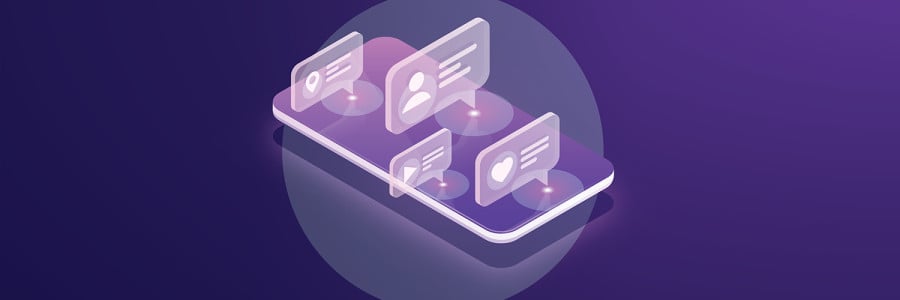
The best and most affordable way to engage your customers.
Due to COVID-19 and the issues surrounding contact tracing, I’ve received numerous questions regarding privacy as it pertains to location-based services. When it comes to privacy and personalization, most people believe that one has to be sacrificed for the other. That is simply not true. A balance can be achieved if you employ the right technology with the right.
As COVID-19 progresses, companies are rethinking their business model, employee relations and marketing strategies. During this time, small businesses are particularly hurting more than others. They need to reconnect with their customers in the most frugal of ways. Plus, they need those connections to convert into sales fairly quickly. So, how can a small company compete and win?
In all my years of marketing, the number one lesson I’ve learned is that you don’t need to have a big budget to communicate like a big brand. Undoubtedly, the first question on your mind is, “How?” The answers are simple, but the solutions have been far more complex — until now.
Typically, companies shoot for the stars and try to find a breakthrough creative idea. Mind you, an inexpensive one that makes sales soar and wins awards like there’s no tomorrow. But as a creative person, I have to tell you that is incredibly hard. Out of a thousand ideas, you may get five or six that truly hit the mark and actually change behavior to that degree. Nonetheless, many brand managers cling to that hope when they lack a budget.
Technology is the great equalizer.
We’ve learned that technology has an incredible amount of power to help brands succeed. It has allowed small companies to win the David and Goliath battle many times over. Yet, the proper application of communications technology eludes most companies. The reasoning is often that they don’t understand it or they are complacent in the success they’ve already had.
For example, the idea behind a company having its own native app. The first answer I generally hear is, “We are too small to have our own app.” For many companies that’s simply not true. Ella Bliss Beauty Bar in Colorado has three locations and a few thousand clients. Their native app crushes it in terms of ROI and their ability to have direct communication with their customers. The other response I’ve received is about priorities. “We need to get a new website done before we tackle an app,” said one client in the car service business. However, their business is comprised nearly 100% based on mobile behaviors. A full-sized website won’t do much to affect their bottom line.
Finally, I have gotten the, “Our business relies on direct mail.” That’s great only if you want to be selling products on sale in a generic fashion. The tactic will never allow you to provide a personalized customer experience — one that aligns a customer’s behaviors. To prove my point, just look at Starbucks. They are not sending you direct mail pieces so you can come in and get a customized coffee to your specifications. They are using their app and the technology in it for drive personalization at a scale never seen before. If they can do it, so can you.
The power of communication is already in your customer’s hands.
The “how” of affordable customer engagement is owning your direct communications channel: a native app. And, with newer technologies like Flutter it’s cheaper than ever. Your customers are demanding personalized communications from you on a timely basis. They may never see your ad or social post. They may take up to a week to open your email. And you have no idea if they receive your direct mail. With a native app and the right push notification strategy, one based on behavior and location no less, you have the ability to connect with your customers at an individual level. On average, push notifications are opened within seconds. And it is the least expensive way to send content to your customers. Yes, even cheaper than email.
Use a customer’s behavior to determine what you should do next.
While Push notifications are ridiculously inexpensive, the biggest advantage they hold is the ability to give you a level of personalization no other channel can match. That’s critical given the fact study, which shows that companies who use personalization will outsell their competitors by 20 percent.
Through the use of a native app with a behavior data set behind it, any company can be its own media company. By no means am I recommending you abandon your other marketing channels. I’m saying you need to seriously reconsider your mix. There’s a phrase, “A bird in the hand is worth two in the bush.” If you are not communicating with your most loyal customers on their terms, then you are missing an opportunity to beat Goliath.
Strategy.
I know this sounds strange, but a technology such as LighthousePE doesn’t necessarily need to know who you are or even your name to deliver a highly personalized communications experience. By simply having a trained algorithm examine the implicit and explicit behaviors of an app’s user, it can determine what the next interaction should be. The algorithm does this though a combination of previously sent communications, executed conversions and location data. That is enough to build a behavioral profile and create a condition for the next behavior to occur.
There is no need to choose between privacy and personalization.
As an example, let’s say you own a car washing company which also provides basic services like an oil change. The greatest value for a company like this is repeat business. Traditionally, this type of organization has relied on coupons to spur customer visits. Those coupons are not personalized. Plus, they reduce revenue every time someone turns one in. Rethink the customer journey and ideate on a new strategy. For example, on the customer’s first customer they receive a deal to come back. The next visit prompts the customer about an oil change. That visit in turn gets them a free polish and shine on their car. Each customer would get something different at this stage based on a specific need. The next visit prompts them to download your app so they can save money and receive a car care plan specific to their needs. In turn, the app delivers other content based on the behavioral data which the algorithm records.
Here’s where the balance between privacy and personalization occurs. The behavioral platform doesn’t need to know the customer, the customer’s name or even what type of car the customer owns. As long as it knows what the time intervals are between visits and which push notifications were converted, the algorithm can make behavioral determinations. That could take the form of a reminder to get an oil change or another standard car maintenance service. It could use prompts related to the weather to spur a visit for another wash or detailing service, or even tell the customer not to come in because it’s going to rain. Location-based technology can do all of that and more while maintaining privacy.
There are a lot of opportunities you can realize with the use of anonymized data.
However, success can only occur when the technology relies on behavioral pattern recognition. Your behavioral models need to account for a customer’s motivations and their ability to perform the behavior needed. By doing that you will find there are plenty of opportunities to prompt an individual to purchase or engage in a unique brand experience at many points along the customer journey.
Although it’s a nice gesture, placing someone’s name at the top of an email is not personalization.
Most people are happy to give up some of their personal data if it’s going to provide them with personalized experiences — 73%, in fact. But that is based on a company being transparent about what it is collecting and how the company is using that data. This means in cases where a customer signs up for a loyalty program through your app, the level of personal data now available to the algorithm can drive personalized experiences to new levels.
Achieving personalization with privacy isn’t a fantasy. It can easily happen with the right behavioral platform and communications strategy.
You may also be interested in
How Consumer Behavior is Changing with AI-Driven Predictive Analytics
Predictive analytics is not a new concept; it has been used in various forms for decades to forecast outcomes based on historical data. However, with the advent of artificial intelligence (AI), predictive analytics capabilities have been exponentially enhanced....
AI: Artificial Intelligence or Artificial Interpretation?
AI is not really Artificial Intelligence—it’s more like Artificial Interpretation. Think about it: AI is not sui generis. It doesn’t make up information. Instead, AI finds correlations in seemingly unrelated information and uses those correlations to interpret...
How the Right AI Can Expand the Casino Player Experience
Most casinos aren’t fully embracing AI, and, in turn, they’re missing opportunities to take care of their existing players and outpace their competition. Unrealized potential awaits—from enjoying the benefits of a true attribution channel to delighting players with...
How AI Automation Will Drive Mobile App Marketing Success
As much as we may hate to admit it, our smartphones and the apps on them have become an essential part of our lives. We use them for everything. They help us order food, shop, bank, and be entertained. Consider this fact: Last year, the number of holiday purchases...





